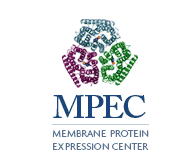Research Focus
Membrane proteins constitute ~30% of all eukaryotic proteins (3), and are targets for over 40% of all drugs in use today (4). There is increasing information on many. We address the need for focus onto pharmacologically important targets. The goals of the MPEC are to express such eukaryotic membrane proteins in novel ways that we have developed and optimize toward each particular class, or each particular membrane protein. Our approach therefore focuses on expression, purification and functional reconstitution of each membrane protein according to its importance for pharmacological or biological purposes. MPEC also pursues structure determination of integral membrane partnerships using X-ray diffraction and Cryo Electron microscopy.
MPEC seeks to membrane proteins in the quality for crystallographic structure determination and CryoEM. Production of eukaryotic membrane proteins.
The largest limitation preventing routine biochemical use of eukaryotic membrane proteins is the limited availability of pure protein from natural or recombinant sources. We develop and apply expression methods. Assays that will be carried out at the MPEC establish stability, structural monodispersity, and oligomeric homogeneity as a key part of the purification and characterization.
Structural biologists have addressed membrane protein expression in biochemical amounts with purification, thus their final product, structures of membrane proteins are a ‘thermometer’ for the state of capabilities today. The exponential growth of the number of structures clearly signal a new capability to purify and characterize membrane proteins once they are expressed.
Thus there is no ‘intrinsic’ problem to eukaryotic membrane proteins per se, any more than there is for eukaryotic soluble protein crystals. However the additional requirement for functional insertion into a membrane of a heterologous organism is often a major problem. Expression of membrane proteins in functional form will allow determination of the molecular cell biology, and drug interactions of many therapeutically, and biologically important membrane proteins once they are expressed (1, 6). The expression outside of naturally occurring sources also allows incorporation of stabilizing mutations (7, 8), and to incorporate special atoms like selenium for structure determination (9). These procedures too can be used to produce stable, well behaved proteins for quantitative biochemistry, drug discovery, and crystallography.
Developing a means to produce large quantities of pure, functional eukaryotic membrane proteins will have a major impact on the future of medicine. It is imperative for our understanding of transmembrane signaling and transport to pursue a concerted effort for a major impact on efforts to understand the basic biochemistry behind transmembrane signaling and transport mechanisms that underlie processes like neurotransmission, cardiovascular regulation, and hormonal signaling, as well as the development of new drugs to treat dysfunctions in these systems.
